
- Japanese trial demonstrated that 8Gbps comms achievable with car travelling at 100 km/h
- Antennas are small, unobtrusive and work well
- Test done over a a straight,2.2 kilometre long course
- Experiment shows that the genuine connected car is getting closer to reality
In a field trial in Japan, DoCoMo, AGC Inc and Ericsson Japan have successfully achieved a world first - 8Gbps 5G comms with a fast moving car fitted with 5G 28 GHz On Glass Antennas (OGA). RF in the 28 GHz band suffers badly from propagation loss and is unable successfully to cover long distances.
However, the installation of an OGA on a vehicle permits radio waves above 6 GHz to be both transmitted and received via "beam forming" technology that concentrates radio waves in a very specific and tightly controlled direction. A complementary "MIMO function" greatly enhances the speed of the communication process by simultaneously transmitting different data from multiple antennas thus allowing stable and high-speed communications with a moving vehicle
The trial took place at the National Institute for Land and Infrastructure Management in Ibaraki Prefecture. The test car was travelling at 100 kilometres per hour and during the trial a maximum comms speed of 8 Gbps was achieved. At the considerably lower speed of 30 km/h that maximum data speed increased to 11 Gbps. The moving test vehicle was fitted with a 5G mobile station to which eight OGA's were connected to the car's windscreen, side windows and rear window.
The antennas are small, unobtrusive, easy to deploy and do not detract from the aesthetic design of the vehicles on which they are mounted. Three 5G base were also set up along the edges of the course. The OGAs received comms signals in combination with the MIMO function and the beam forming capability with four beams supporting both vertical and horizontal polarisation.
The trial tok place on a straight section of course some 2.2 kilometres in length.s
Original Press Release and photos below
Success with 5G communications using "vehicle glass mounted antenna" for 5G connected car
Tokyo, July 25, 2018: NTT DOCOMO, INC. (DOCOMO) and AGC Inc. (AGC) today achieved the world's first1 8 Gbps 5G communications with a fast-moving vehicle equipped with "vehicle glass mounted antennas" (On-Glass Antennas) in a field trial conducted in conjunction with Ericsson Japan.
The 5G 28 GHz band compatible On-Glass Antennas used in the field trial were designed and developed by AGC. The antennas are not easily seen from the exterior and can be installed on glass surfaces without affecting the vehicle design.
Radio waves in the 28 GHz band have a large propagation loss and have difficulty propagating over long distances. By installing an On-Glass Antenna on the vehicle, radio waves above 6 GHz can be transmitted and received using the "beam forming function", which concentrates radio waves in a specific direction, and the "MIMO function", which improves communication speed by simultaneously transmitting different data from multiple antennas. This allows stable, high-speed communications even for vehicles in operation.
For this field trial, 5G high-speed communications using both the beam forming function and the MIMO function was performed with a vehicle equipped with On-Glass Antennas. The trial was held at the National Institute for Land and Infrastructure Management in Ibaraki Prefecture, Japan. While moving at high speeds of approximately 100 km/h, a maximum communication speed of 8 Gbps was achieved, and a maximum of 11 Gbps was achieved at a speed of approximately 30 km/h, confirming that high-speed in-vehicle communications in the 28 GHz band can be achieved by utilizing On-Glass Antennas.
DOCOMO, AGC, and Ericsson Japan will continue working toward utilizing 5G in various environments including in-vehicle communication modules, etc., aiming to see 5G connected cars become a reality.
According to research carried out by DOCOMO (as of July 25, 2018).
1. Field trial outline and results
The trial was carried out at a straight section of test course approximately 2.2 km long at the National Institute for Land and Infrastructure Management. 5G data communications were carried out using the 28 GHz band between the moving test vehicle equipped with a 5G mobile station to which several On-Glass Antennas were connected and three 5G base stations set up along the sides of the course.
For this trial, a total of eight On-Glass Antenna elements were installed in the test vehicle on the windshield, both side windows, and rear window, so that radio waves could be received from various directions.
By utilizing the On-Glass Antennas to receive signals in combination with the MIMO function and the beam forming function with up to four beams supporting vertical and horizontal polarization, 5G high-speed communications were realized, with up to 8 Gbps at a moving speed of approximately 100 km/h, and 11 Gbps at a moving speed of approximately 30 km/h.
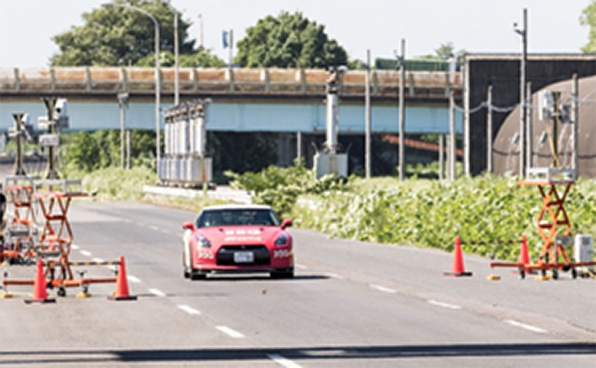 Fig.1 Scene of field trial
Fig.1 Scene of field trial
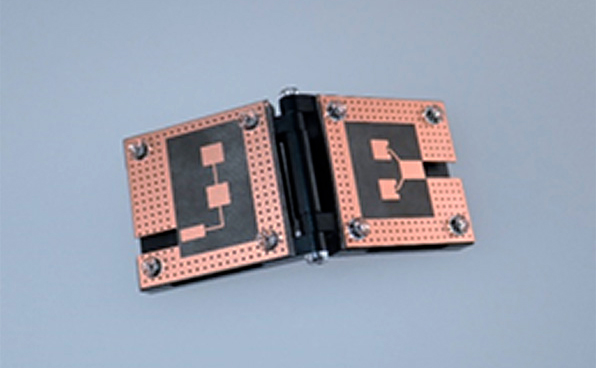 Fig.2 On-Glass Antenna element
Fig.2 On-Glass Antenna element
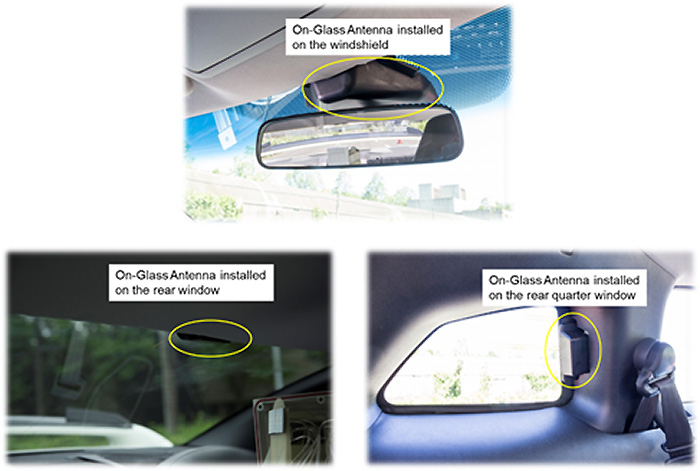
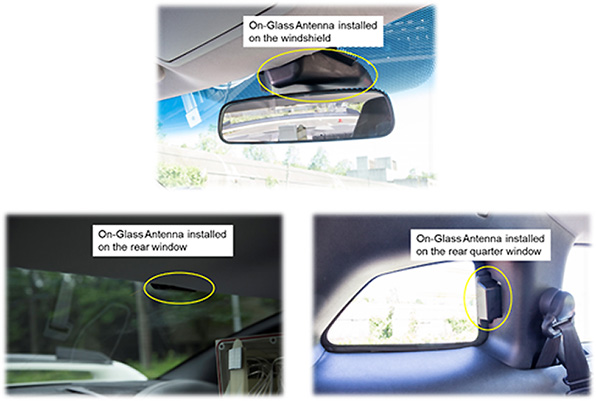 Fig.3 Installation examples of On-Glass Antennas
Fig.3 Installation examples of On-Glass Antennas
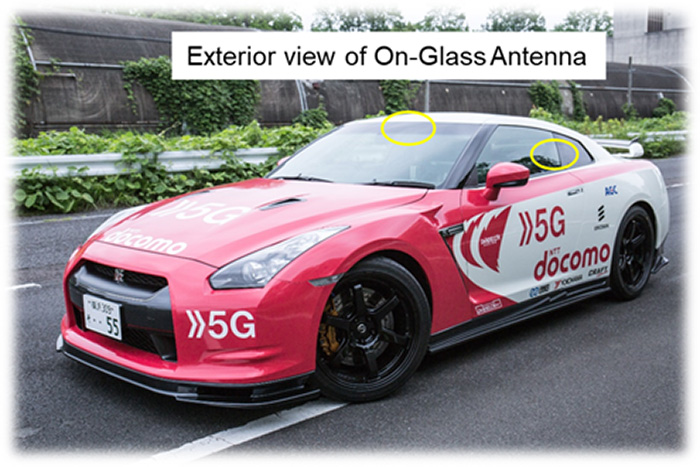 Fig.4 Exterior of vehicle with On-Glass Antennas installed
Fig.4 Exterior of vehicle with On-Glass Antennas installed
2. Test period June 28, 2018 - July 25, 2018
3. Frequency band used 28 GHz band (bandwidth: 732 MHz)
4. System configuration for field trial
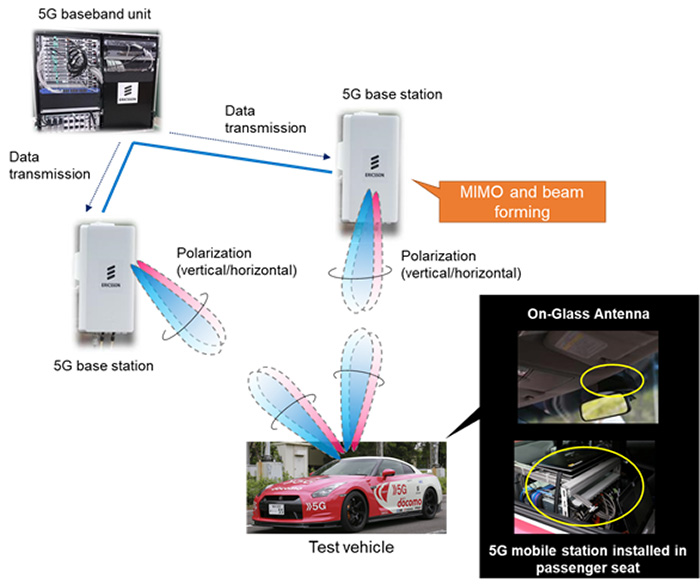
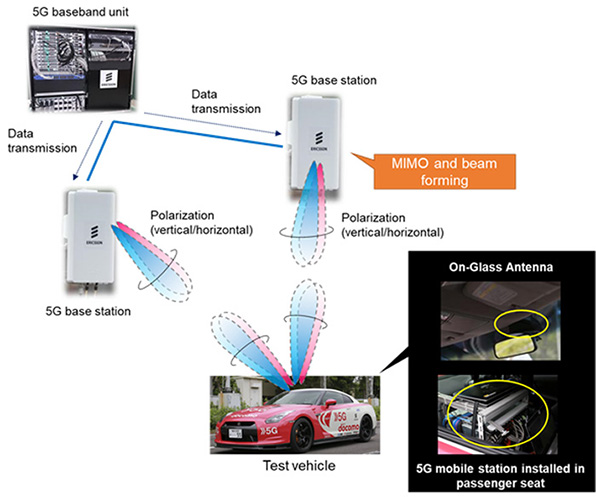 Fig.5 System configuration
Fig.5 System configuration
Main Specifications of Field Trial5G system5G base stations
- MIMO function (supporting vertical/horizontal polarization, 2 x 64 elements for each polarization, transmitting up to two beams per base station during trial)
-
Beam forming function, beam-tracking function 5G On-Glass Antenna
-
Supporting vertical/horizontal polarization, four elements for each polarization 5G mobile station
-
Receiving up to four beams Test vehicle
-
NISSAN GT-R
5. Roles of each company
Company NameRoleDOCOMO
- Planning and promotion of entire field trial
-
5G area design AGC
-
Design and development of On-Glass Antenna Ericsson Japan
-
Provision and operation of 5G base station and mobile station equipment
6. Video of experiment
 https://www.youtube.com/watch?v=5JT6s2m3a3I (in Japanese only)
https://www.youtube.com/watch?v=5JT6s2m3a3I (in Japanese only)
Email Newsletters
Sign up to receive TelecomTV's top news and videos, plus exclusive subscriber-only content direct to your inbox.



